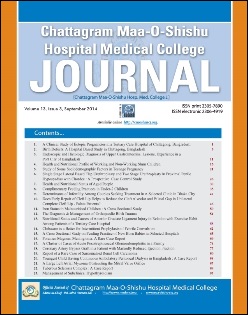Iron Status in Malnourished Children : A Cross Sectional Study
DOI:
https://doi.org/10.3329/cmoshmcj.v13i3.21024Keywords:
Serum iron, TIBC, TSATAbstract
Objectives: Malnutrition is a common condition among children and iron status varies in different types of malnutrition. So the present study is aimed to find the different iron status among severe malnourished children in our context.
Methods: A hospital based cross sectional study was done in the Paediatrics ward Chittagong Medical College Hospital in a period of 6 months from January to July 2013 among the 50 cases of malnourished children of age range between 1 to 5 years and Weight for Height Z score(WHZ) was <-2 SD. Sampling technique was continuous purposive sampling. Venous blood was collected to assay the different iron profile mainly serum iron level, total iron binding capacity(TIBC) and transferrin saturation(TSAT). Data was analyzed after correction by SPSS-19.
Results: Among the 50 study children of different age groups 15 patients were 1 to 2 years, 18 patients were 2 to 3 years, 10 patients were 3 to 4 years and 7 patients were at 4-5 years of age groups. Among the patients, 29 (58%) of patients were female and 21(42%) of the patients were male. Most of the children were from the families of low socioeconomic status 38(76%). 2(4%) children were from upper middle class who had step mother. Among the selected patients the dominating clinical features were anemia was found among 45(90%) of patients which was mild(66.6%), moderate(26.6%) and severe(6.6%). Skin changes(32%), eye changes (10%) and hair changes(48%) were also found. Among the 50 study subjects prelacteal feeding was given among 43(86%) children, breast feeding was given 45(90%), exclusive breast feeding was given to 24(48%) of children and complementary feeding after 6 months was given to 29(58%) patients. Among the 50 patients -2 to -3 SD weight for height was found in 20(40%) patients and <-3 SD was found in 30(60%) patients. Most of the children was found to have Mid Upper Arm Circumference (MUAC) 115-125 mm(50%). Iron status was measured among all patients where serum iron level was found 77.72 ± 11.22 mcgm/dl, TIBC was found 340.07 ± 22.67 mcgm/dl and transferrin saturation was found 22.38 ± 2.9 %. Iron status were measured among the different types of malnutrition where serum iron level and transferrin saturation was high among all patients with malnutrition while TIBC was lower than standard level in all patients. Different biochemical status were measured among the different types of malnutrition where serum total protein, serum albumin, Hb% were lower than standard level in all patients.
Conclusion: Change in different iron status is a common findings in malnourished children. Screening of all children for anemia and providing iron and folic acid (IFA) or multiple micronutrients (MMN) supplements to children and Infant and Young Child Feeding (IYCF) should be addressed at all level to overcome the situation.
Downloads
313
263
Downloads
Published
How to Cite
Issue
Section
License
Authors of articles published in CMOSHMC Journal retain the copyright of their articles and are free to reproduce and disseminate their work.
A Copyright and License Agreement -signed and dated by the corresponding author on behalf of all authors -must be submitted with each manuscript submission.

